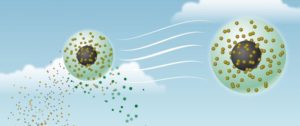There is much that is being learned about air pollution on the move. For example, the distances Polycyclic Aromatic Hydrocarbons or PAHs traveled, how they are affected while in flight and what their impact is on human health are all areas researchers explored in a recent collaborative study conducted by Oregon State University (OSU), the Pacific Northwest National Laboratory (PNNL) and Peking University.
In “Globe-trotting pollutants raise some cancer risks four times higher than predicted,” an Oregon State University news release, published Jan. 26, 2017, this is all detailed.
“A new way of looking at how pollutants ride through the atmosphere has quadrupled the estimate of global lung cancer risk from a pollutant caused by combustion, to a level that is now double the allowable limit recommended by the World Health Organization.
“The findings, published this week in the Proceedings of the National Academy of Sciences Early Edition online, showed that tiny floating particles can grow semi-solid around pollutants, allowing them to last longer and travel much farther than what previous global climate models predicted.
“Scientists said the new estimates more closely match actual measurements of the pollutants from more than 300 urban and rural settings.”
What’s disturbing is the danger these so-called “globe-trotting pollutants” present to human health.
The study’s lead author, Manish Shrivastava, a PNNL scientist wrote: “‘This work brings together theory, lab experiments and field observations to show how viscous organic aerosols can largely elevate global human exposure to toxic particles, by shielding them from chemical degradation in the atmosphere,’” as noted in the release.
From the burning of fossil fuels, consumption of biofuels and fires from forests, released are pollutants and in these certain chemicals, namely, polycyclic aromatic hydrocarbons, several of which, as identified by the U.S. Environmental Protection Agency, are known agents that cause cancer, information in the OSU release went on to point out.
“These tiny airborne particles form clouds, cause precipitation and reduce air quality, yet they are the most poorly understood aspect of the climate system.”
The PAHs react differently with different chemicals in different conditions. For example, “Recent experiments led by PNNL coauthor Alla Zelenyuk show that, depending on the conditions, the aerosol coatings can actually be quite viscous. If the atmosphere is cool and dry, the coating can become as viscous as tar, trapping PAHs and other chemicals. By preventing their movement, the viscous coating shields the PAHs from degradation.”
Moreover, researchers “using both old and new models,” looked at the extent of the protected pollutants’ journeys – across whole continents and oceans.
“Globally, the previous model predicted half a cancer death out of every 100,000 people, which is half the limit outlined by the World Health Organization (WHO) for PAH exposure. But using the new model, which showed that shielded PAHs actually travel great distances, the global risk was four times that, or two cancer deaths per 100,000 people, which exceeds WHO standards.”
Noted in the release also was the extent to which the WHO standards were exceeded which varied throughout different regions of the world. The extent, according to OSU, was greater in China and India and less in Western Europe and the U.S. In mid- and high-latitudes, meanwhile, compared to the tropics, shielding extent was much greater. “As the aerosols traversed the warm and humid tropics, ozone could get access to the PAH’s and oxidize them.”
As pointed out, uncertainty remains as to what this means to future environmental and human health risk assessments, Shrivastava going on to explain, “‘[w]e need to better understand how the shielding of PAHs varies with the complexity of aerosol composition, atmospheric chemical aging of aerosols, temperature and relative humidity. I was initially surprised to see so much oxidation over the tropics.’”
For more information see: “Tracking pollution: Research helps explain air-contaminant survival” here.
Article updated on Feb. 12, 2017 at 9:39 p.m. Pacific Standard Time.
Notes
- Illustration originally credited to Oregon State University. Information has since been updated to reflect proper attribution.
Illustration credit: Pacific Northwest National Laboratory

The illustration credit should be Pacific Northwest National Laboratory. (not OSU)
Thank you for that.
Thank you for correcting!